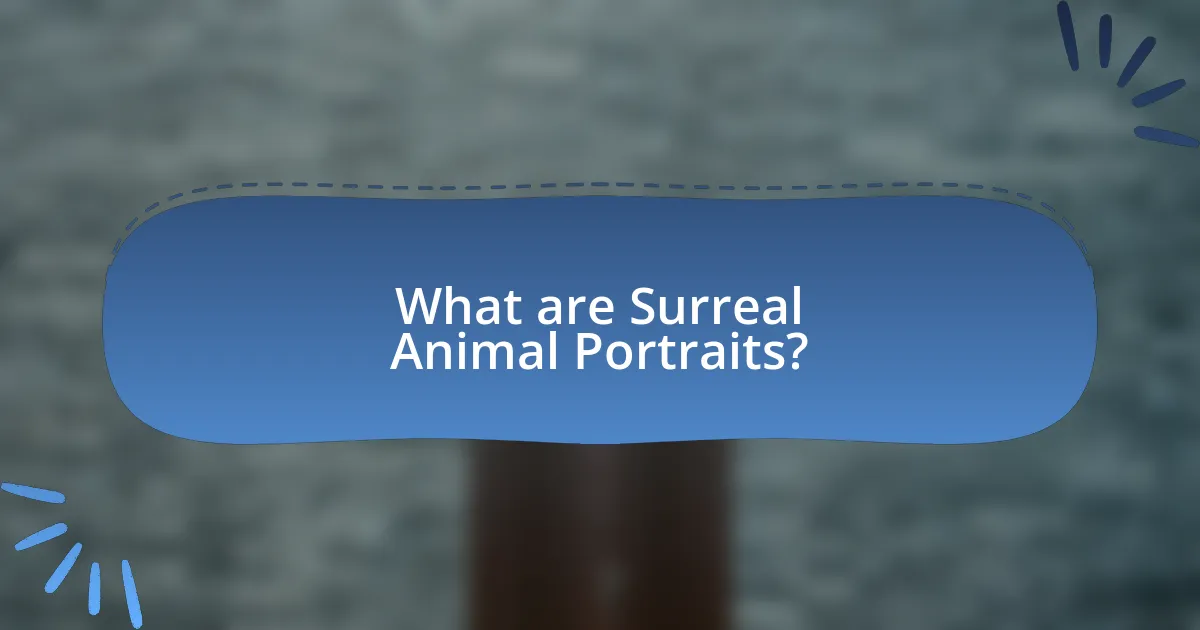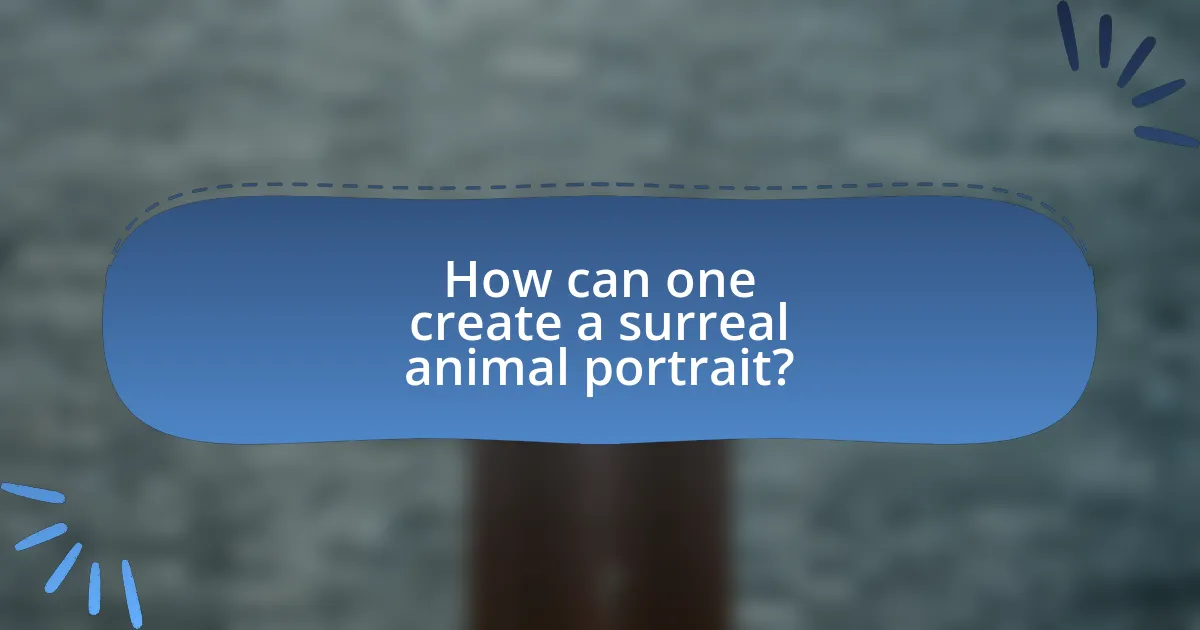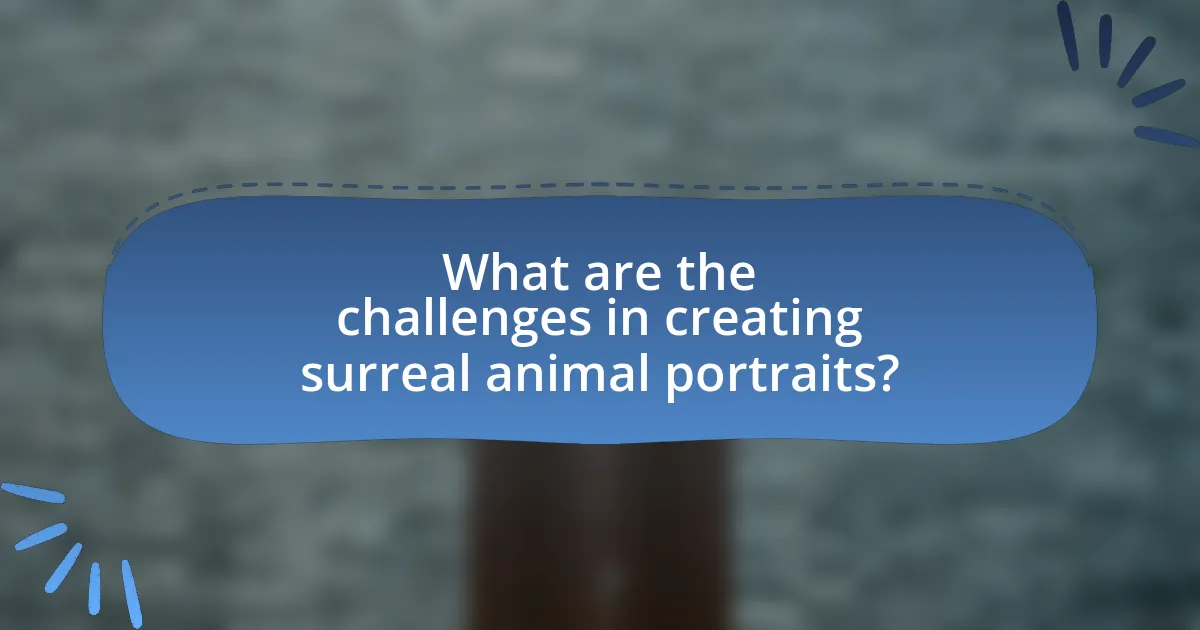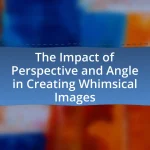Surreal animal portraits are artistic representations that depict animals in imaginative and whimsical scenarios, often incorporating humor and unexpected elements. This article explores the differences between surreal and traditional animal portraits, highlighting the artistic techniques used, such as juxtaposition and exaggerated features, to create engaging visuals. It also discusses prevalent themes like anthropomorphism and dreamlike landscapes, the role of humor in enhancing viewer engagement, and practical tips for artists on creating these unique artworks. Additionally, the article addresses challenges artists may face, strategies for maintaining originality, and resources for further learning about surreal art techniques.

What are Surreal Animal Portraits?
Surreal animal portraits are artistic representations that depict animals in dreamlike, fantastical, or illogical scenarios, often blending elements of humor and whimsy. These portraits challenge conventional perceptions of animals by incorporating unexpected features, settings, or narratives, creating a visual experience that evokes curiosity and imagination. The genre draws inspiration from surrealism, a movement that emerged in the early 20th century, characterized by its exploration of the unconscious mind and dream imagery. Artists like Salvador Dalí and René Magritte have influenced this style, which often employs techniques such as juxtaposition and distortion to create striking and thought-provoking images.
How do surreal animal portraits differ from traditional animal portraits?
Surreal animal portraits differ from traditional animal portraits primarily in their imaginative and fantastical elements. While traditional animal portraits focus on realistic representations of animals, capturing their physical traits and behaviors, surreal animal portraits incorporate dreamlike scenarios, exaggerated features, and whimsical contexts that challenge reality. For instance, a traditional portrait may depict a dog sitting in a natural setting, whereas a surreal portrait might show the same dog wearing a crown and floating among clouds. This divergence highlights the surrealists’ intent to evoke emotions and provoke thought, often using humor and absurdity, which contrasts sharply with the straightforward depiction found in traditional art forms.
What artistic techniques are commonly used in surreal animal portraits?
Surreal animal portraits commonly utilize techniques such as juxtaposition, dreamlike imagery, and exaggerated proportions. Juxtaposition involves placing animals in unexpected contexts or combinations, creating a sense of surprise and intrigue. Dreamlike imagery often incorporates elements that defy logic, such as floating objects or distorted backgrounds, enhancing the surreal quality. Exaggerated proportions, where certain features of the animal are amplified or minimized, contribute to a whimsical and humorous effect. These techniques collectively engage viewers by challenging their perceptions and evoking emotional responses, making surreal animal portraits a unique form of artistic expression.
Why is humor an essential element in surreal animal portraits?
Humor is an essential element in surreal animal portraits because it engages viewers and provokes thought through unexpected juxtapositions. Surrealism often challenges reality, and incorporating humor allows artists to create a playful atmosphere that invites interpretation. For instance, the use of absurd scenarios or anthropomorphic traits in animal portraits can elicit laughter while simultaneously prompting deeper reflections on human-animal relationships and societal norms. This duality enhances the viewer’s experience, making the artwork memorable and impactful.
What themes are prevalent in surreal animal portraits?
Prevalent themes in surreal animal portraits include anthropomorphism, dreamlike landscapes, and whimsical humor. Anthropomorphism allows animals to exhibit human traits, creating a connection between the viewer and the subject. Dreamlike landscapes often serve as backdrops, enhancing the surreal quality and evoking emotions. Whimsical humor is frequently employed to challenge perceptions and provoke thought, making the artwork engaging and memorable. These themes collectively contribute to the unique and imaginative nature of surreal animal portraits, as seen in the works of artists like Salvador Dalí and contemporary creators who blend reality with fantasy.
How does whimsy influence the portrayal of animals in art?
Whimsy significantly influences the portrayal of animals in art by encouraging artists to depict them in imaginative and playful ways. This artistic approach often results in anthropomorphized animals engaging in humorous or absurd scenarios, which can evoke joy and provoke thought. For instance, artists like Salvador Dalí and contemporary creators such as Lisa Congdon utilize whimsy to challenge traditional representations of animals, transforming them into symbols of creativity and freedom. The use of vibrant colors, exaggerated features, and surreal settings further enhances this whimsical portrayal, making the artwork more engaging and memorable.
What role does imagination play in creating surreal animal portraits?
Imagination is essential in creating surreal animal portraits as it allows artists to transcend reality and explore fantastical concepts. This creative process enables the combination of real animal features with whimsical elements, resulting in unique and thought-provoking artworks. For instance, artists may envision animals with exaggerated characteristics or placed in unusual settings, which challenges viewers’ perceptions and evokes emotional responses. The imaginative aspect is supported by the fact that surrealism often aims to unlock the subconscious, as noted by André Breton, a key figure in the surrealist movement, who emphasized the importance of dreams and imagination in artistic expression.

How can one create a surreal animal portrait?
To create a surreal animal portrait, one should combine realistic animal features with unexpected elements or settings that challenge perception. This can be achieved by manipulating proportions, incorporating dreamlike backgrounds, or adding whimsical accessories that do not typically belong to the animal. For instance, artists often use techniques such as digital manipulation or mixed media to blend various textures and colors, creating a striking contrast that enhances the surreal quality. The effectiveness of this approach is supported by the popularity of surrealism in art history, where artists like Salvador Dalí and René Magritte employed similar techniques to evoke emotion and provoke thought.
What materials and tools are needed for creating surreal animal portraits?
To create surreal animal portraits, essential materials and tools include high-quality drawing paper or canvas, a variety of pencils for sketching, and paints such as acrylics or watercolors for vibrant colors. Additionally, brushes of different sizes, an eraser, and possibly digital tools like graphic tablets and software for digital art are also important. These materials enable artists to blend realistic animal features with imaginative elements, enhancing the whimsical aspect of the portraits. The use of diverse tools allows for a range of textures and effects, which are crucial in surreal art.
How do different mediums affect the final outcome of the portrait?
Different mediums significantly influence the final outcome of a portrait by altering texture, color saturation, and overall visual impact. For instance, oil paints provide rich colors and a smooth finish, allowing for detailed blending and depth, which can enhance the surreal aspects of animal portraits. In contrast, watercolor creates a softer, more ethereal effect, often resulting in lighter tones and fluid transitions that can evoke whimsy. Additionally, digital mediums offer versatility and the ability to easily manipulate elements, enabling artists to experiment with various styles and effects that traditional mediums may not allow. Each medium thus contributes uniquely to the portrayal of humor and whimsy in surreal animal portraits, shaping the viewer’s experience and interpretation.
What are the steps involved in the creative process of making a surreal animal portrait?
The steps involved in the creative process of making a surreal animal portrait include conceptualization, sketching, digital or traditional rendering, and final adjustments. Conceptualization involves brainstorming ideas and themes that blend humor and whimsy, often inspired by the characteristics of the chosen animal. Sketching translates these ideas into visual form, allowing for experimentation with composition and surreal elements. Rendering, whether digitally or traditionally, brings the sketch to life with color, texture, and detail, emphasizing the surreal aspects. Finally, final adjustments refine the artwork, enhancing contrasts, colors, and any surreal features to achieve the desired effect. Each step is crucial for creating a compelling and imaginative portrait that resonates with viewers.
What techniques can enhance the humor and whimsy in these portraits?
Exaggeration of features can enhance the humor and whimsy in portraits by creating a playful distortion of reality. Techniques such as enlarging eyes, elongating limbs, or emphasizing quirky expressions can evoke laughter and a sense of lightheartedness. Additionally, incorporating unexpected elements, like animals in human clothing or surreal backgrounds, adds an imaginative twist that engages viewers. Research in visual perception indicates that humor often arises from incongruity, supporting the effectiveness of these techniques in eliciting amusement.
How can color choices impact the mood of the portrait?
Color choices significantly impact the mood of a portrait by evoking specific emotional responses. For instance, warm colors like reds and oranges can create feelings of warmth and excitement, while cool colors such as blues and greens often evoke calmness and tranquility. Research in color psychology indicates that colors can influence perceptions and emotions; for example, a study published in the journal “Color Research and Application” found that warm colors are associated with energy and enthusiasm, while cool colors are linked to relaxation and serenity. Therefore, the selection of colors in a portrait directly shapes the viewer’s emotional experience and interpretation of the artwork.
What are some common visual puns used in surreal animal portraits?
Common visual puns in surreal animal portraits include anthropomorphism, where animals are depicted with human traits or behaviors, such as wearing clothing or engaging in human activities. Another frequent visual pun is the juxtaposition of animals with unexpected objects or environments, like a fish in a teacup or a bird perched on a typewriter, creating a humorous contrast. Additionally, artists often use visual wordplay, such as a “catfish” portrayed as a cat with fish-like features, to blend literal and figurative meanings. These techniques enhance the whimsical nature of the portraits while inviting viewers to engage with the humor embedded in the artwork.

What are the challenges in creating surreal animal portraits?
Creating surreal animal portraits presents challenges such as balancing realism with imaginative elements. Artists must skillfully integrate fantastical features while maintaining recognizable traits of the animals, which can lead to a disjointed visual experience if not executed well. Additionally, achieving a cohesive color palette and composition that enhances the surreal aspect without overwhelming the viewer is complex. The challenge is further compounded by the need for originality; artists must innovate to avoid clichés in surrealism, which can dilute the impact of their work. These factors require a deep understanding of both artistic techniques and the psychological effects of surreal imagery on the audience.
How can artists overcome creative blocks when working on surreal animal portraits?
Artists can overcome creative blocks when working on surreal animal portraits by engaging in brainstorming techniques, such as mind mapping or free association, to generate new ideas. These methods encourage the exploration of unconventional concepts and connections, which are essential in surrealism. Additionally, artists can seek inspiration from various sources, including nature, literature, and other art forms, to stimulate their imagination. Research indicates that exposure to diverse stimuli can enhance creativity by fostering new neural connections (Kounios & Beeman, 2009). Furthermore, setting specific goals and deadlines can provide structure, helping artists to focus their efforts and reduce the overwhelming feeling that often accompanies creative blocks.
What strategies can be employed to maintain originality in artwork?
To maintain originality in artwork, artists can employ strategies such as exploring diverse influences, experimenting with techniques, and developing a unique voice. By drawing inspiration from various cultures, art movements, and personal experiences, artists can create distinctive pieces that reflect their individuality. Experimentation with different mediums and styles allows for innovation, leading to fresh interpretations and ideas. Additionally, cultivating a personal artistic voice through consistent practice and self-reflection helps artists to express their unique perspectives, ensuring their work stands out in a crowded field. These strategies are supported by the fact that many successful artists, such as Pablo Picasso and Frida Kahlo, drew from a wide range of influences and maintained a distinctive style that resonated with their audiences.
How can feedback from others improve the quality of surreal animal portraits?
Feedback from others can significantly enhance the quality of surreal animal portraits by providing diverse perspectives that highlight strengths and weaknesses in the artwork. When artists receive constructive criticism, they can identify areas for improvement, such as composition, color usage, or thematic elements, which may not be apparent to them. Research indicates that peer feedback fosters artistic growth; for instance, a study published in the Journal of Creative Behavior found that artists who actively sought and incorporated feedback improved their skills more rapidly than those who worked in isolation. This collaborative approach not only refines technical abilities but also encourages innovative ideas, ultimately leading to more engaging and imaginative surreal animal portraits.
What are common mistakes to avoid in surreal animal portrait creation?
Common mistakes to avoid in surreal animal portrait creation include neglecting anatomical accuracy, which can lead to unrealistic portrayals that detract from the intended whimsy. Additionally, failing to establish a cohesive color palette may result in visual dissonance, undermining the overall impact of the artwork. Overcomplicating the composition with excessive elements can also confuse the viewer, diluting the humor and whimsy that surrealism aims to convey. Lastly, not considering the emotional expression of the animal can lead to portraits that lack personality, making them less engaging. These mistakes can hinder the effectiveness of the surreal animal portrait and diminish its artistic value.
How can an artist ensure their humor is well-received in their work?
An artist can ensure their humor is well-received in their work by understanding their audience and tailoring the humor to resonate with them. This involves researching the preferences and cultural references of the target demographic, as humor can vary significantly across different groups. For instance, a study published in the Journal of Personality and Social Psychology indicates that humor is often more appreciated when it aligns with the values and experiences of the audience. Additionally, incorporating relatable situations or universal themes can enhance the humor’s effectiveness, as seen in successful comedic art that often reflects shared human experiences.
What pitfalls should be avoided to maintain the whimsical nature of the art?
To maintain the whimsical nature of surreal animal portraits, artists should avoid overly serious themes and excessive realism. Serious themes can detract from the playful essence that defines whimsy, while excessive realism can undermine the imaginative qualities that engage viewers. For instance, maintaining a balance between humor and creativity is essential; if the artwork becomes too literal or somber, it risks losing its lighthearted appeal. Additionally, artists should steer clear of clichés that may render the work predictable, as originality is crucial for evoking a sense of wonder and delight.
What practical tips can enhance the creation of surreal animal portraits?
To enhance the creation of surreal animal portraits, artists should focus on incorporating unexpected elements and vibrant colors. Utilizing unconventional backgrounds, such as dreamlike landscapes or abstract patterns, can create a striking contrast with the animal subject, enhancing the surreal effect. Additionally, experimenting with proportions and perspectives can lead to unique interpretations of the animal, making the portrait more engaging. For instance, exaggerating features like eyes or limbs can evoke humor and whimsy, aligning with the theme of blending humor with whimsy in surreal art. Furthermore, integrating mixed media techniques, such as collage or digital manipulation, can add depth and complexity to the artwork, allowing for greater creative expression.
How can artists find inspiration for their surreal animal portraits?
Artists can find inspiration for their surreal animal portraits by exploring the intersection of reality and imagination, often drawing from nature, mythology, and personal experiences. Engaging with diverse sources such as wildlife documentaries, art history, and literature can spark unique ideas, while experimenting with different artistic techniques and mediums allows for innovative expressions. For instance, the works of Salvador Dalí and René Magritte demonstrate how blending familiar elements with unexpected twists can create compelling surreal imagery. Additionally, participating in art communities and seeking feedback can further enhance creativity and provide new perspectives.
What resources are available for learning more about surreal art techniques?
Books, online courses, and art workshops are valuable resources for learning surreal art techniques. Notable books include “Surrealism: The Road to the Unconscious” by David G. Friedrich, which explores the principles of surrealism, and “The Art of Surrealism” by John T. Spike, providing insights into techniques and artists. Online platforms like Skillshare and Udemy offer courses specifically focused on surreal art, allowing learners to engage with practical exercises. Additionally, local art schools often conduct workshops that focus on surreal techniques, providing hands-on experience and guidance from instructors. These resources collectively enhance understanding and skill in creating surreal art.


